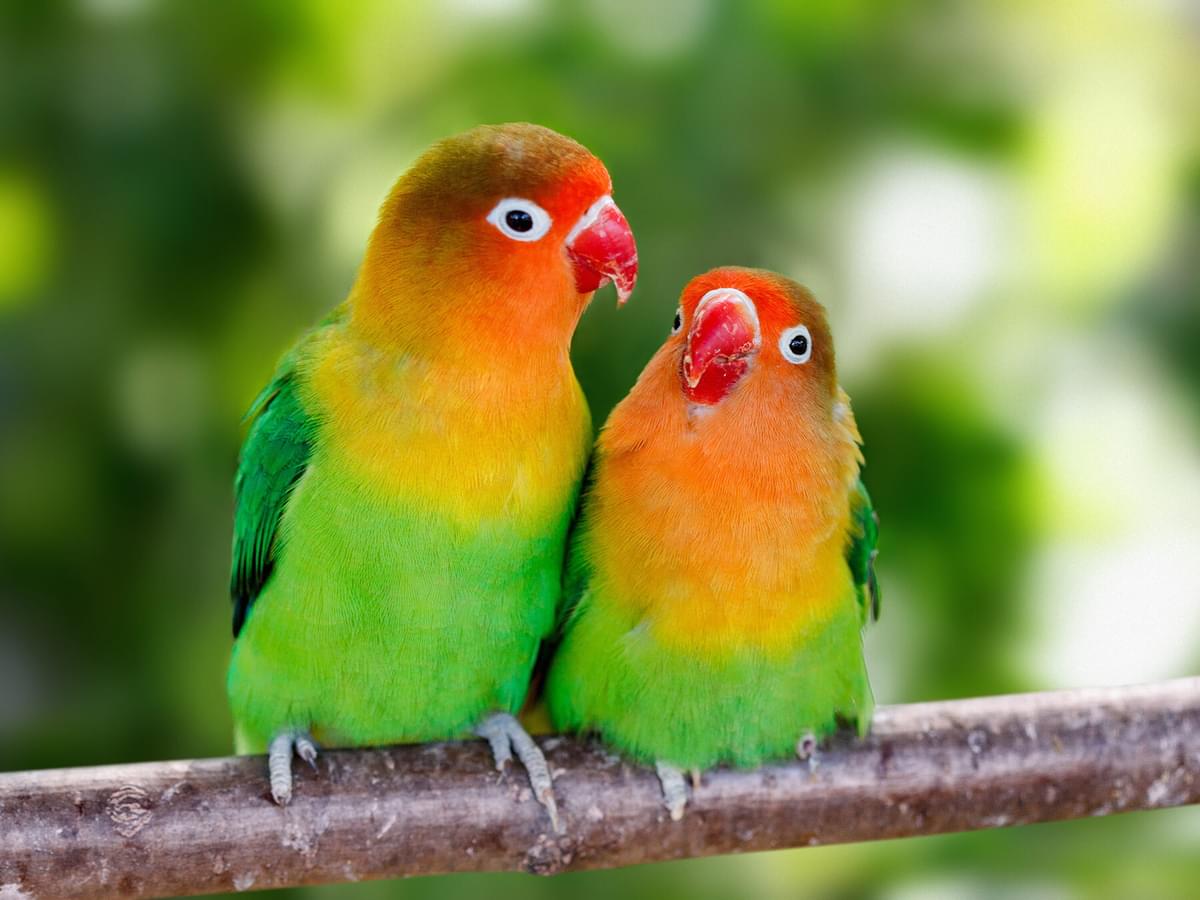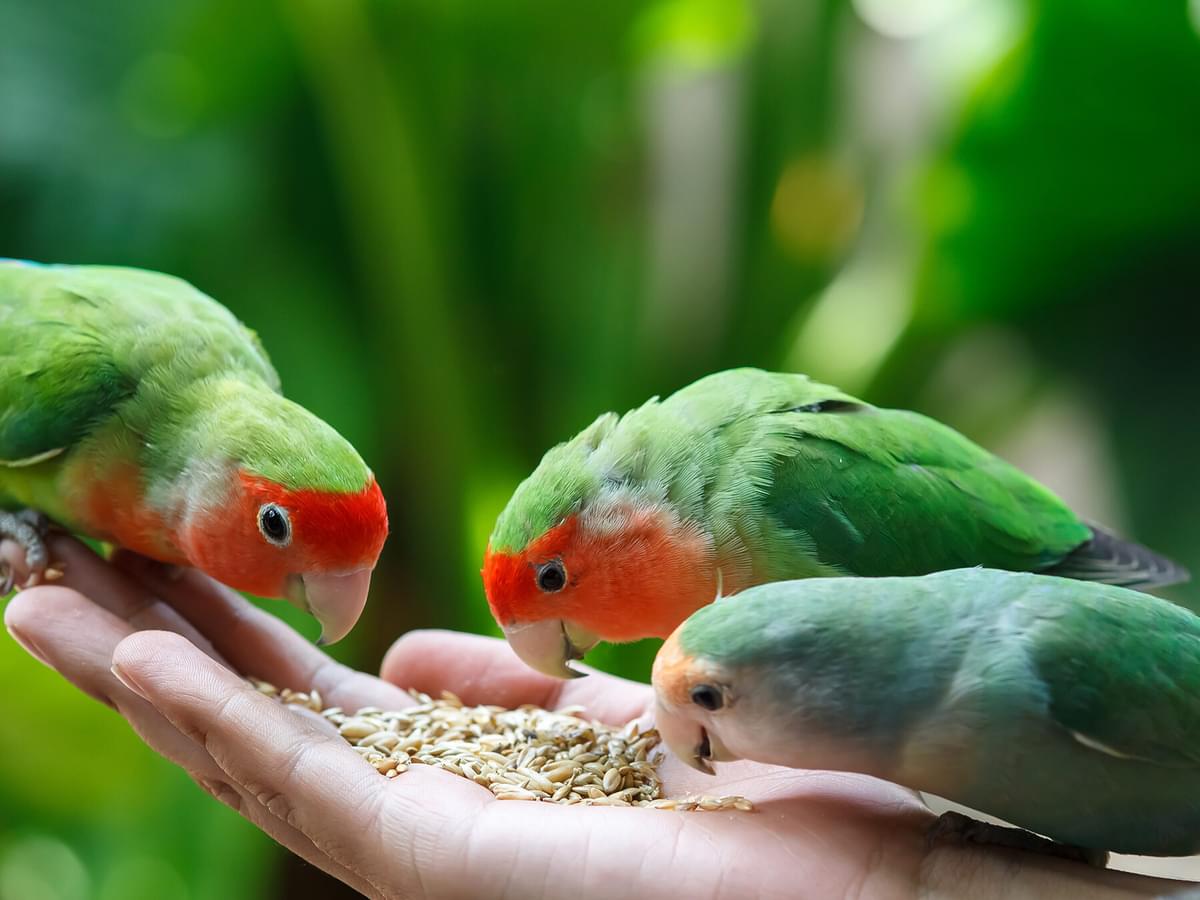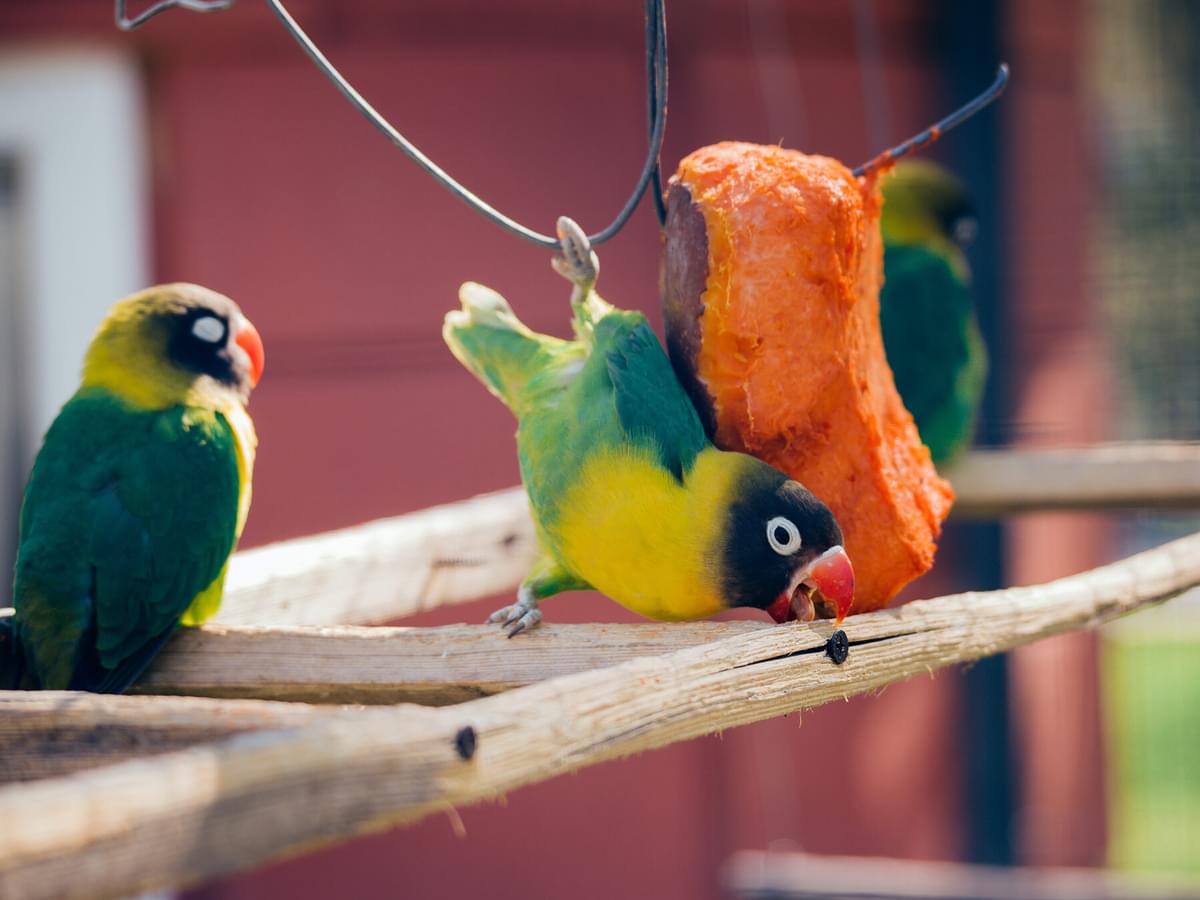Jump to Section
What Do Lovebirds Eat? (Lovebird Diet, Behavior and Habits)
Last updated: 10 June 2022

Lovebirds are a group of nine species of small parrots from the genus Agapornis. All nine species are native to Africa. Lovebirds are one of the most popular pet birds, loved for their sociability, intelligence, and colorful personalities. Here, we’re going to answer the question in detail: what do lovebirds eat?
In the wild, virtually all species of lovebirds eat primarily seeds, fruits, buds, leaves, and other plant foods. A couple of species do also eat small quantities of insects and invertebrates, such as the Black-cheeked and Black-winged lovebirds, which eat insects and their larvae. The Rosy-faced lovebird, the most popular pet lovebird, has a flexible diet, consuming fruits, grains, seeds, vegetables, and grasses.
In captivity, lovebirds should ideally be fed a diet that mimics their natural diet. This should contain fruit, seeds, nuts, vegetables, grains, grasses, and purpose-made pellet food. Some lovebirds are hard to keep healthy in captivity, such as the Black-collared lovebird, which ideally needs to feed on figs native to its habitat.
Lovebirds are highly dependent on water and usually soften their food before eating it. Therefore, providing them with a constant supply of fresh lukewarm water is essential.
Of course, there is much more to learn about lovebird diets - read on to find out!

A pair of lovebirds eating seeds together
What feed do lovebirds eat?
Lovebirds should be fed a purpose-made feed. The feed should be enriched with other fresh foods, such as seeds, fruits, and vegetables. The feed will likely contain a blend of seeds, fortified with additional vitamins, minerals, and other nutrients.
It’s often worth trying out a few different brands and blends to see which one the lovebirds prefer. Many lovebird feeds are the same or similar to parakeet or macaw feeds.
While feed should make up the majority of a lovebird’s diet, it needs to be enriched with other fruits, vegetables, and fresh whole plant foods. As a rule, fresh foods should make up around 25% of their diet by weight.
Knowing how much to feed your lovebirds often takes trial and error, but in general, around 1 to 1.5 tablespoons of feed should be offered per bird each day.

Two lovebirds eating corn
What do lovebirds eat in the wild?
In the wild, lovebirds are almost solely herbivorous. They consume a wide range of fruits, vegetables, seeds, nuts, and various other plant foods such as leaves and buds. Some lovebirds are dependent on specific foods, such as figs, whereas others are more flexible.
Lovebirds consume whatever plant foods are abundantly available in their habitats seasonally, including seasonal fruits and grasses. Lovebirds often become highly sociable when consuming fruit, feeding together in large flocks.
Most species of lovebirds feed avidly on grains and grasses, such as millet and maize, which they’ll happily take from farmers’ fields. Consequently, some species, such as the Rosy-faced lovebird, are considered a pest in some parts of Africa.

A black-winged lovebird (Agapornis taranta) in the wild, eating a guava fruit
How do lovebirds find food?
Lovebirds forage from fields, forests, woodlands, and tropical and semi-tropical jungles. They’re pretty flexible when foraging and finding food.
Near human settlements, lovebirds often flock to fields to forage grains and seeds such as sunflower, millet, and maize. Like other parrots, lovebirds have strong bills that they use to crack open the husks of seeds.
What are lovebirds' favorite food?
Lovebirds often have different preferences - finding their favorite food is a matter of trial and error!
Broadly speaking, seeds such as millet are their favorite staple foods, though lovebirds will probably eat many different varieties of seeds. They also love fresh fruit, especially kiwi, figs, plums, grapes, watermelons, and citrus.

A pair of Lilian's lovebirds perched on a branch, in the wild
What should lovebirds eat daily?
All species of lovebirds require a nutritionally diverse diet that combines fresh foods with a purpose-made lovebird or parrot mix or pellet.
The seed mix will contain a number of seeds, grains, grasses, and other nutritional compounds. It should make up around 20 to 25% of the lovebirds’ diet by weight, approximately 1 1/2 to 2 ounces (45 to 60 grams) per bird. This should equate to around 1 to 1.5 level tablespoons.
The remainder should consist of fruits, vegetables, legumes, and other fresh foods. Try different foods to see what the lovebirds prefer - some will have a sweeter tooth and prefer fruit, whereas others will prefer more savory vegetables!
What is harmful to lovebirds?
Lovebirds shouldn’t be fed with anything high in salt, sugar, or salt. Some specific foods that are potentially harmful to lovebirds include:
- Onions
- Garlic
- Chocolate
- Avocado
- Mushrooms
- Certain herbs and plants
- Dairy
- Pits from cherries, plums, apricots, and peaches
- Apple seeds

Three lovebirds eating seeds from the hand
What vegetables can lovebirds eat?
Lovebirds can eat a huge variety of leafy greens and other types of vegetables.
Finding out what your lovebird enjoys is a matter of trial and error, so be sure to offer them a wide selection of foods and narrow things down based on what they are and aren’t eating.
Here are some popular vegetables lovebirds can eat:
- Lettuce
- Spinach
- Carrots
- Peas
- Tomatoes
- Parsley
- Radish
- Cucumber
- Broccoli
- Kale
- Bell peppers
- Beetroot
What fruits can lovebirds eat?
Lovebirds can eat practically all common fruits. However, one important thing to point out is that the seeds and pits should be removed in nearly all instances (especially in the case of apples).
Again, getting to the bottom of what fruits your lovebird likes is a matter of trial and error. Offer a wide variety of foods and note down what they eat and seem to enjoy the most.
Don’t overfeed lovebirds with certain foods just because they appear to like them - they need a diverse diet consisting primarily of seeds.
Here are some popular fruits for lovebirds:
- Bananas
- Citrus
- Berries
- Mango
- Fig
- Melon
- Kiwis
- Grapes
- Plums
- Pears
- Watermelon

A lovebird eating a selection of fresh fruit and vegetables
What do lovebirds eat for treats?
Once you’ve been feeding your lovebirds for a while, you should get an idea of the foods they really like.
Popular treats include fresh fruits, grasses, and seeds such as sunflower and millet. So long as a lovebird has a diverse, rich diet, it doesn’t need ‘treats’. Don’t overfeed lovebirds on any one particular type of food - they require a diverse diet to thrive.
How often do lovebirds eat?
Lovebirds are usually fed in the morning, and will then eat their feed throughout the day when they need it. Enriching foods such as fruits should be fed once or twice daily.
If the lovebird is just a baby, you’ll likely need to feed it every hour if it's a hatchling, up to around 1-week old, and every 2 to 3 hours thereafter, until it’s 2 to 3-months old. Only experienced keepers should attempt to raise newborn lovebirds.

Two lovebirds enjoying a pumpkin
What do baby lovebirds eat?
Baby lovebirds should be with a high-quality baby bird formula (typically using a syringe into the mouth).
You have to check the bird’s crop to ensure it’s bulged from the food and stop feeding then. This continues for a couple of weeks at least, at which point the bird is weaned onto a fine seed mix. Only experienced keepers should attempt to raise baby lovebirds.
What do lovebirds like to drink?
Lovebirds require a constant supply of water. Water should never be cold, but just about lukewarm if possible.
Many lovebirds drink as much as 10 ounces (300ml) a day! So keep topping up their water bowl whenever it’s getting empty.

Pair of Yellow-collared Lovebirds (Agapornis personatus) taking a drink of water
Are lovebirds vegetarian?
Lovebirds almost solely consume plant foods in the wild, with some exceptions.
For example, the Black-cheeked and Black-winged lovebird eats larvae and small insects. The most common lovebird kept in captivity, the Rosy-faced lovebird, is considered vegetarian, or herbivorous.
Pet or captive lovebirds thrive on a rich vegetable and seed-based diet, but some rarer specialist species require specific diets. The Rosy-faced lovebird is the most popular pet lovebird because it has a straightforward and flexible diet.
Lovebird Diet FAQs
Can lovebirds eat bananas?
Bananas are soft and nutritious - they’re great for lovebirds!
Can lovebirds eat sunflower seeds?
Lovebirds eat sunflower seeds in their native habitats - they’re one of their staple foods. Sunflower seeds are in most seed mixes, but can also be fed to lovebirds whole.
Can lovebirds eat grapes?
Lovebirds should only be fed seedless grapes, but yes, grapes are a soft and nutritious food.
Can lovebirds eat apples?
Lovebirds enjoy apples, but it’s essential that any seeds are removed as these are potentially hazardous to the birds.

Two lovebirds perched next to one another
Can lovebirds eat carrots?
Carrots are soft and nutritious - excellent for lovebirds!
Can lovebirds eat bread?
Bread isn’t nutritious and shouldn’t be fed to lovebirds, or any birds for that matter, except wholemeal or granary bread. Don’t feed your lovebirds with bread.
Can lovebirds eat rice?
Lovebirds eat rice in their native habitat. You can feed them uncooked or cooked rice - choose wholemeal or wild rice if possible.
Can lovebirds eat peanut butter?
There are mixed sentiments on whether birds should be fed with peanut butter. Overall, it’s best to avoid feeding lovebirds peanut butter as it’s high in fat and often contains additives. Lovebirds don’t need peanut birds to thrive.
On this page
- What feed do lovebirds eat?
- What do lovebirds eat in the wild?
- How do lovebirds find food?
- What are lovebirds' favorite food?
- What should lovebirds eat daily?
- What is harmful to lovebirds?
- What vegetables can lovebirds eat?
- What fruits can lovebirds eat?
- What do lovebirds eat for treats?
- How often do lovebirds eat?
- What do baby lovebirds eat?
- What do lovebirds like to drink?
- Are lovebirds vegetarian?
- Lovebird Diet FAQs

